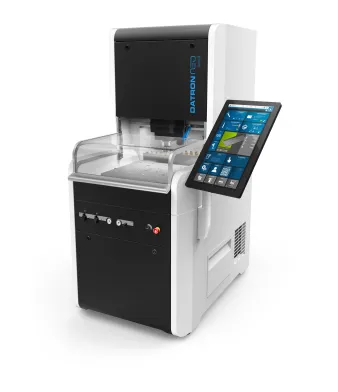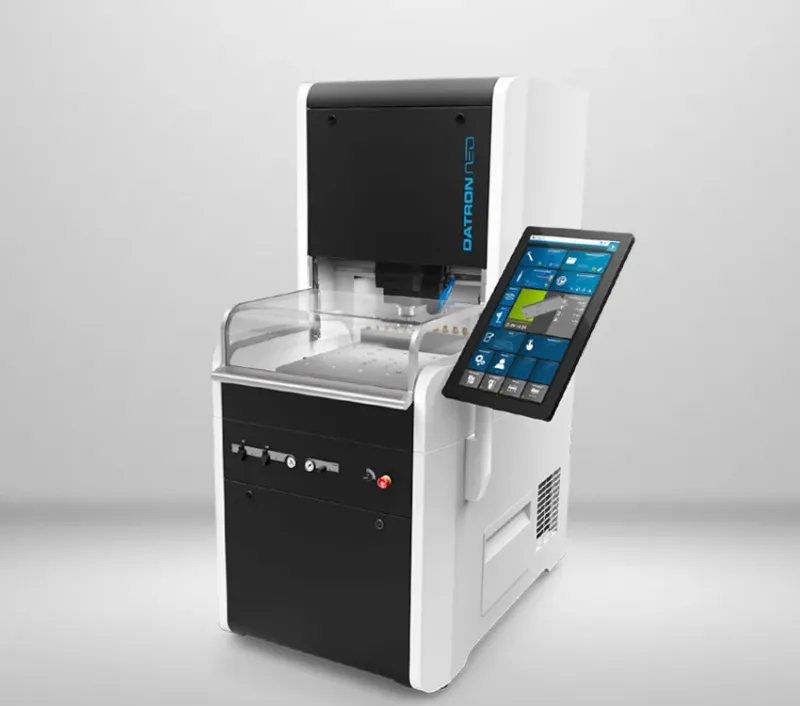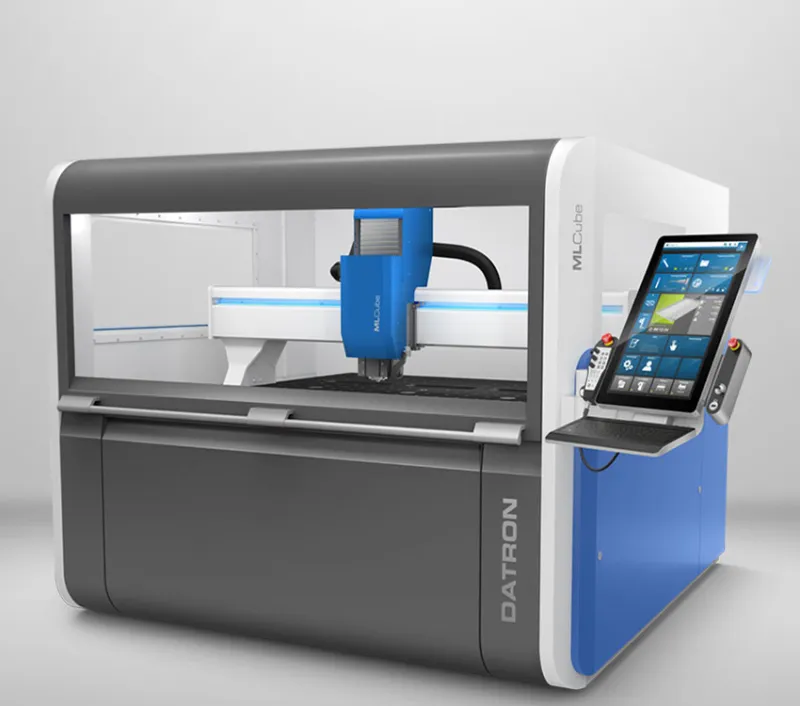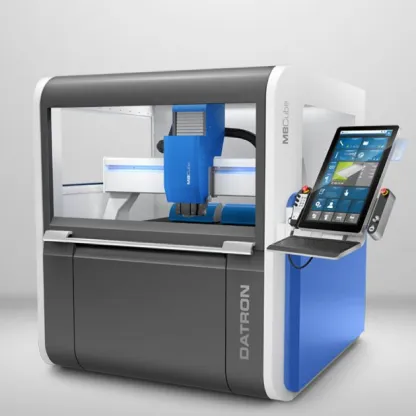North America | Global
North America | Global

Over the past few decades, industrial engraving has experienced much growth and changes. From the adoption of CNC machine engraving to growing laser technologies, far more options are available to industrial engravers today to produce embossing dies, stamping dies, sharp face dies, combination dies, serialization, stainless steel engraving, and molds. Gone are the days of hand or manual engraving on pantographs.
Software has also experienced significant developments, making it much easier and faster to transform from a digital image into metal patterns or cavities. More stringent environmental regulations have negatively impacted the production of industrial engravings. Now, making chemical etching is far more complex and expensive. In these rapidly changing times, DATRON has remained an established industry leader and a preferred solution for the engraving industry for over 30 years.
Choosing the right industrial engraving equipment requires a strategic evaluation of your production needs, material properties, and machine capabilities. To effectively produce an industrial engraving, you need a process that can manufacture diework efficiently, accurately, and with quality surface finishes. Typical low-cost tabletop engraving machines are too light and not heavy-duty enough to engrave harder metals like steel. They are intended for engraving soft materials, like plastic. Heavier equipment such as a CNC machine is rigid and heavy enough but generally is equipped with low RPM spindles and is inefficient when using small engraving tools. You need a heavy CNC machine with a 40,000-RPM spindle or higher to engrave metals effectively. Laser engraving offers efficiency, accuracy, and quality surface finishes, but it has limitations with certain materials, struggles with deep metal engraving, and comes with high operational costs. DATRON offers high efficiency, precision, superior surface finishes, deep engraving, and cost-effective operation on nearly any material.

When evaluating the right technology and equipment for your industrial engraving operation, it is essential to consider the workflow. The workflow consists of the entire process from design to finished part. When evaluating CNC equipment, consider key processes such as the machine interface, material securing, part orientation, tool setup time, and coolant requirements. Additionally, assess how easily finished designs can be removed and post-processing needed to complete the engraving. For laser engraving, you need to consider the user interface and how easy it is to adjust the laser settings for optimal performance. Some processes take significant time, such as adjusting the laser’s focal length, making power adjustments, performing sample cuts on test pieces, and determining if multiple passes are needed for deeper cuts and proper alignment. In decision-making, you should evaluate how both technologies require setup time.
With DATRON, the entire workflow process is designed to be quick and easy for industrial engraving. The app-driven touchscreen interface machine control allows a novice or non-machinist to quickly learn and operate the system. Optical cameras and touch probes can automatically locate and orient parts, even if the material is not straight. The touch probe can measure the flatness of the material and compensate for any surface variances, ensuring perfect engraving depths critical in making dies or molds. The vacuum table system secures your part or nest of parts quickly and easily without taping or clamping. The automatic tool changer has a large capacity with a tool length measurement system that allows you to check for worn or broken tool tips.

In “lights out” industrial engraving, the system automatically checks the tool after completing a toolpath. If the tip breaks, it replaces it with a sister tool and recuts the operation—all without the operator present. Therefore, you arrive in the morning to complete production without tool-related downtime. A smartphone app that monitors the machine remotely is also available. The tool length measurement adjusts after every change, recalibrating and compensating for wear to ensure precise and aligned cut depths. The oilless coolant mist system for non-ferrous material extends tool life and requires no cleanup. For engraving steel stamps or stainless-steel panels, oil can also be used in the same system. DATRON’s high-speed spindle shortens engraving times and optimizes the process for maximum daily and lights-out production.
Maintenance and cost of ownership are other factors you need to evaluate when deciding on a technology or machine. Large machining centers usually require weekly maintenance on the flood coolant systems. Plus, replacing and disposing of retired coolants is expensive, and it is time-consuming to clean filters. Laser systems consume a lot of energy to run and operate. The energy cost per part can be high with the longer cycle times associated with the laser system. The DATRON systems use a coolant that simply evaporates, requiring no part cleanup and minimal maintenance for the coolant system. Compared to a standard handheld hair dryer, the DATRON neo runs on less power, ensuring highly efficient energy consumption.

DATRON offers four types of machines that can accommodate various engraving needs. The neo is the smallest and most affordable machine, offering a 20″ x 16 1/2″ work area with a 40,000 RPM spindle and 24 tool station capacity. This is an excellent machine for producing any kind of die work, including a 4th rotary axis option for rotary dies.
The M8Cube offers a 30″ x 40″ work volume with optional spindles up to 60,000 RPM. For larger-size dies or running nested parts, the M8Cube is ideal for lights-out production. Some M8Cube customers lay down a large sheet of engraver’s brass on the vacuum table system, run multiple engraving work orders, and in the end, have the machine rout out the individual plate sizes. Setting up and running multiple jobs overnight or over a weekend is easy.
The MLCube is similar in design to the M8Cube, offering a larger 40″ x 60″ work volume. The fourth machine is the MXCube, DATRON’s most rigid and accurate machine tool with a 30″ x 40″ work area. This machine is a good option if surface finishes and accuracy are critical.
The design and construction of all DATRON systems are unique, featuring a steel framework combined with vibration-dampening polymeric concrete. These features provide the rigidity required for demanding surface finishes in the engraving industry. The engraving surface finish quality is at the level of a several-ton machine tool but only a fraction of the weight. Therefore, you can commission a machine in almost any environment without significant site preparation work like you would with a 10-ton machine tool. The DATRON is more agile than a traditional VMC because it moves a lighter mass. Therefore, it can accelerate and decelerate much faster than a conventional machine tool. Since most designs and artwork have very short and changing vector lengths, this is particularly important for engraving. DATRON achieves impressive cycle times compared to heavier VMC machines, often 4 – 6 times faster.

Part of the process of selecting a piece of equipment should involve a test cut or benchmark performed by the equipment supplier. It isn’t easy to measure a technology’s true value and performance based on specifications and claims. A step further would also witness the part being engraved either virtually or in person. The best approach is to design a simple test part with all key details your company needs. These include accuracy, surface finish, engraving depth, toolpath alignment, fine detail, and cycle time. Evaluate the entire process quickly during a visit to the supplier’s showroom if the test part is under an hour. The onsite evaluation should include the ease of integration between your artwork and machine, the workflow in setting up the workpiece, and, most importantly, the company representing the equipment. Considerations include how long the company has been in business, the size of its service and support team, its local spare part inventory, and the annual maintenance required with the equipment. Cost of ownership and downtime are critical to the overall success of your decision.
At DATRON, we offer a benchmarking service to evaluate your needs properly. Our team will program your part, engrave the sample, and send you a comprehensive document. This document outlines the details of your benchmark, such as tools used and cycle times. A video of your part being engraved will be included, allowing you to review the process before visiting our showroom for a live demonstration.

DATRON’s local industry-leading support team is available for any support or advice you may need years after you have purchased a machine. The machine components are all plug-and-play, meaning replacing machine components may not require a service technician to visit your facility. Do it yourself, saving time and money.
DATRON is ready to support you throughout your decision-making process, ensuring that you select the best equipment for your needs. Our team is available to assist with any questions, and their machines offer long-term support and ease of operation.
Ready to transform your industrial engraving process? Contact our team today for expert guidance and discover how DATRON’s reliable, user-friendly machines can elevate your production.


